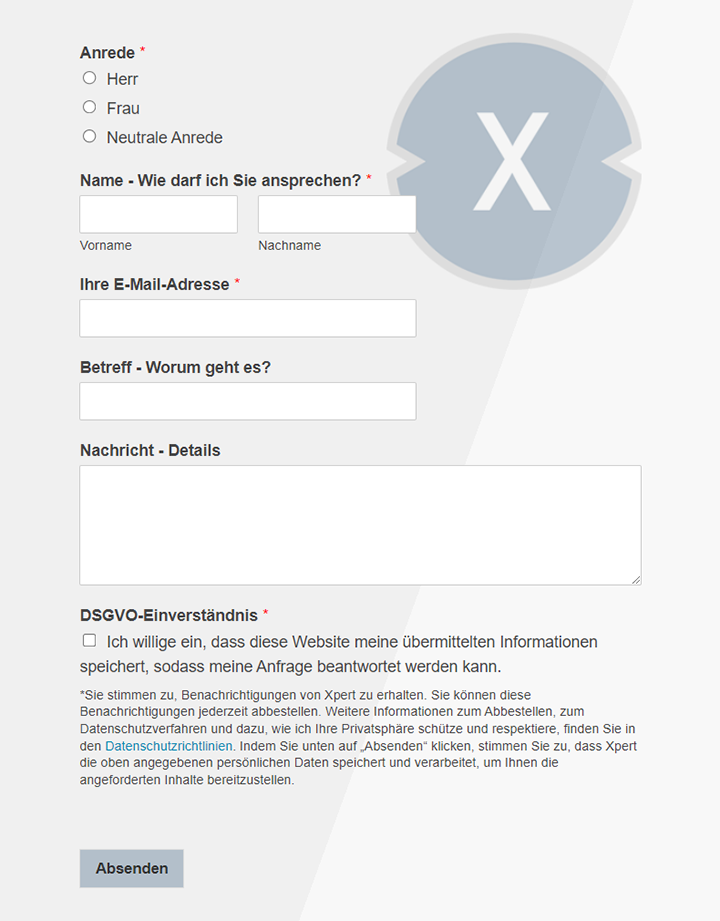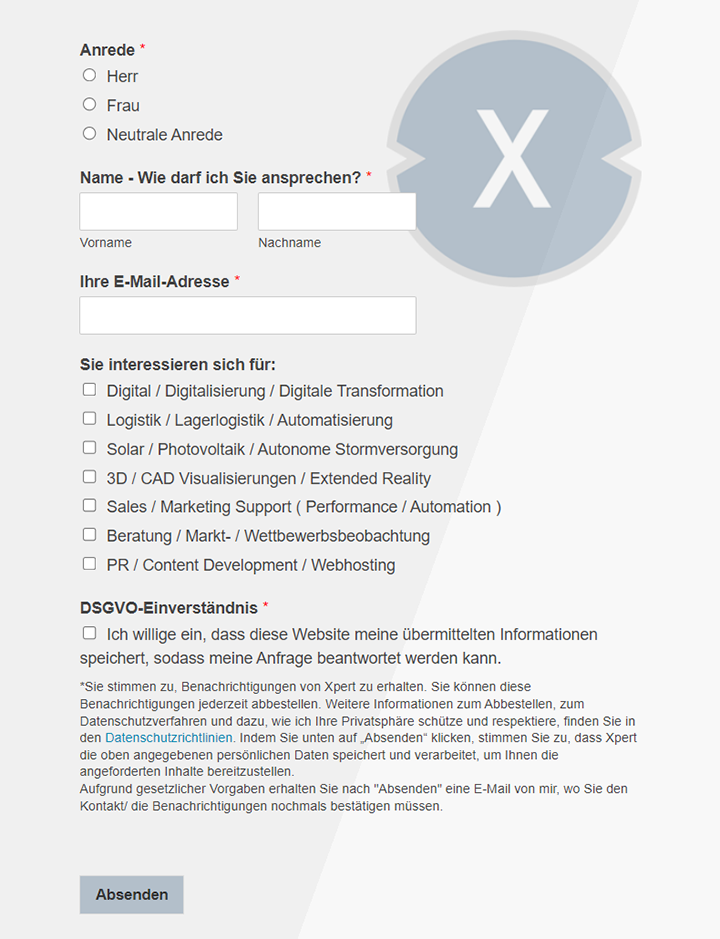Market development of battery stores, trade stores and large storage in Germany, Europe, China, Japan and South Korea
Xpert pre-release
Language selection 📢
Published on: February 20, 2025 / update from: February 20, 2025 - Author: Konrad Wolfenstein

Market development of battery storage, commercial storage and large storage in Germany, Europe, China and other regions - Image: Xpert.digital
Global trends and challenges in the market for battery storage
How battery storage ensure network stability and efficiency
The market development in the area of battery storage shows enormous growth on a global level. Large and commercial stores are becoming increasingly important in order to ensure network stability, smooth load tips and use renewable energies efficiently. PV Magazine's updated market overview emphasizes that 75 providers with more than 390 products and services are now represented in this sector - a clear indicator of the expansion and diversification of this market.
Versatility and applications of battery storage
The versatility of modern battery stores is remarkable. On average, seven out of fourteen possible areas of application for storage solutions are mentioned, whereby the most commonly mentioned application cases are:
- Smoothing of load tips - avoiding expensive load tips by storing energy.
- Optimization of self -consumption - maximizing the electricity that is used yourself from renewable energy sources.
- Smoothing of generation tips - ensuring uniform feed -in on the net.
- Use as a chargingbooster - acceleration of the loading of electric vehicles and reducing the network load.
- Additional important areas of application include the provision of primary control, use in virtual power plants and marketing on energy and control energy markets.
Growth and development of business models
In addition to hardware development, the service sector is also expanding around battery storage. Important services are:
- EPC services (engineering, procurement, construction)-turnkey solutions for battery storage.
- Planning and optimization - integration of storage systems into existing energy networks.
- Monitoring and control - intelligent software solutions for real -time monitoring.
- Trade on energy markets - participation in control energy markets for network service.
- These developments show the growing interest and the increasing importance of battery storage in the energy transition.
Market development in different regions
The worldwide market development shows dynamic growth with regionally different trends.
Suitable for:
Germany and Europe
Germany is one of the leading markets for battery storage systems (BESS) in Europe and has significant growth. According to forecasts, battery production in Germany is to reach a capacity of almost 400 gigawatt hours per year by 2030, which corresponds to about a quarter of the entire European production.
Europe plans to increase its production capacities for battery cells to up to 1.5 terawatt hours by 2030. The United Kingdom in particular drives the development of battery stores. In particular, the regulatory framework and investments in the network infrastructure are crucial here.
China
China dominates the global market for battery energy storage systems and is expected to further expand its market leadership. Chinese battery manufacturers are currently checking about 80% of the global market for battery cells and secure a large part of the critical minerals for production. The Chinese government actively supports the expansion of battery production and storage in order to strengthen energy independence and reduce emissions.
Japan and South Korea
Japan has ambitious goals to implement battery storage. It is estimated that a battery storage capacity of 3 to 4 gigawatts is to be expanded by 2030.
South Korea has played a leading role in battery production and development in recent years. Especially companies such as LG Energy Solution and Samsung SDI invest massively in new technologies. South Korea is expected to take a top position in the installations in the coming years before it is overtaken by China.
Battery energy storage: a key technology for climate neutrality
The global market for battery energy storage is expected to grow from $ 25.02 billion in 2024 to $ 114.05 billion in 2032, with an average annual growth rate of 20.88%. By 2040, a cumulative installed battery storage capacity of 942 gigawatts is expected, which requires a total of $ 620 billion.
Market driver
- Renewable energies: The growing proportion of renewable energies such as solar and wind power makes battery storage indispensable to stabilize the networks.
- Network stability: memory solutions are used to compensate for frequency fluctuations and network lumps.
- Falling costs: Progress in battery production and scale effects lead to continuous cost reductions.
- Political support: Governments worldwide promote the expansion of battery storage through subsidies and legal framework conditions.
Comparison of market shares: Europe vs. Cina
Europe
Europe, especially Germany, dominates the market for home storage systems. In 2020, around 70% of the home stores installed in Europe accounted for Germany. The leading manufacturers in this segment are:
- BYD
- sunbathe
- Senec
- E3/DC
These four companies covered more than three quarters of the German market in 2021 and 2022. In addition to Germany, Italy, Great Britain, Austria and Switzerland are important markets. Together, these five countries make up 93% of all home stores installed in Europe.
China
China dominates the global market for battery energy storage systems:
- Chinese battery manufacturers control about 67% of the battery cell market.
- Catl, a Chinese company, holds a global market share of about 38% for power storage for “electromobility”.
Other leading Chinese manufacturers are:
- BYD
- Ganfeng lithium
- Calb
- Eve Energy28
Chinese companies account for around 60% of the global market for battery cells. CATL and BYD are the leading manufacturers who together make up about 55% of the global market . If you add other Chinese companies in the top 10, the proportion increases to 67.1%. This dominance extends across the entire value chain, from raw material extraction to battery cell production .
With a market share of around 43 %, CATL remains the undisputed market leader overall, followed by BYD with around 25 %. This dominance is supported by the strong demand for lithium iron phosphate batteries (LFP) and the comprehensive control of the value chain in China.
In comparison, it shows that China takes a significantly stronger position in the global battery market than Europe. While Europe, especially Germany, is a leader in home storage systems, Chinese companies dominate the overall market for battery storage and cells. The Asian supremacy in the battery market is underlined by the fact that no European company is more represented among the top 10 global battery manufacturers.
Suitable for:
- Battery storage and automobile: The punitive tariffs of US President Donald Trump against Mexico and Canada also meet Germany
- Technology disaster for battery storage? Experts raise the alarm due to frequent failures and lack of software
Technology and demand: The key role of battery storage in the energy transition
The battery storage market is located worldwide in a dynamic growth phase. While Europe, especially Germany, takes up a leadership role in storing home, China remains the dominant player in global battery production and will further expand this lead.
The technological development, political framework and the increasing need for renewable energies will continue to promote the expansion of the battery storage market in the coming years. In an increasingly electrified world, efficient and powerful storage systems will be a load -bearing pillar of the energy transition.
🎯🎯🎯 Benefit from Xpert.Digital's extensive, fivefold expertise in a comprehensive service package | R&D, XR, PR & SEM

AI & XR 3D Rendering Machine: Fivefold expertise from Xpert.Digital in a comprehensive service package, R&D XR, PR & SEM - Image: Xpert.Digital
Xpert.Digital has in-depth knowledge of various industries. This allows us to develop tailor-made strategies that are tailored precisely to the requirements and challenges of your specific market segment. By continually analyzing market trends and following industry developments, we can act with foresight and offer innovative solutions. Through the combination of experience and knowledge, we generate added value and give our customers a decisive competitive advantage.
More about it here:
Global trends and challenges in the market for battery storage: a comprehensive analysis
Growth markets for battery storage: battery storage as a key to the integration of renewable energies
The market for battery storage is experiencing unprecedented dynamics and rapid growth worldwide. This development is not only an indicator of technological progress, but also a decisive factor for the success of the global energy transition. Battery stores are no longer a niche technology, but have become a central pillar of a sustainable and resilient energy supply. Especially in the context of the increasing integration of renewable energies such as solar and wind power, they play an indispensable role to compensate for the inherent fluctuations in these energy sources and ensure network stability.
The importance of battery stores manifests itself in various areas of application, which range from the stabilization of large -scale power grids to optimizing self -consumption in private households. This versatility makes battery storage a key element for a future -oriented energy infrastructure. The growing number of providers and products on the market underlines the expansion and diversification of this sector. Current market overviews show an impressive variety of actors and solutions that boost competition and drives innovations.
Battery storage: Guarantee for network stability and efficiency
The primary function of battery storage in the energy system is to ensure network stability and efficiency. In a world that is increasingly shaped by volatile renewable energies, memory becomes an indispensable instrument to maintain the balance between energy generation and consumption. They make it possible to store excess energy when production is high- for example due to wind or sunlight- and to feed them back into the network if necessary. This ability is crucial to minimize frequency fluctuations and to prevent voluntary slumps that could endanger the stability of the entire network.
In addition, battery memory contributes significantly to the increase in efficiency of the energy system. They allow energy to use when it is most valuable and not mandatory when it is produced. This optimizes the use of renewable energies, reduces discounting measures and minimizes the need for conventional power plants, which are often inefficient and harmful to the environment. The ability to optimize load tips and self -consumption are other aspects that significantly improve the efficiency of the energy system through battery storage.
Versatility and areas of application of battery storage
The versatility of battery storage is remarkable and extends over a wide range of applications. Modern storage solutions are not limited to a single application, but can be used flexibly in different areas to address different challenges in the energy system. On average, a variety of possible areas of application are identified for memory solutions, whereby some applications particularly stand out:
Splaring of load tips: increase in efficiency and reduction in costs
The smoothing of load tips is one of the most common and economically attractive applications for battery storage. Industrial and businesses, but also network operators are often faced with high costs for load tips that arise from short-term but intensive power consumption. Battery stores offer an elegant solution here by storing energy in times of low needs and handing it over when the load tips occur. This not only reduces the energy costs for the end consumers, but also relieves the power grid and contributes to avoiding overload. The ability to capsize load tips makes battery stores a valuable instrument for efficient load management and optimized network utilization.
Optimization of self -consumption: maximizing renewable energies in the household and trade
In the private and commercial sector, the optimization of self-consumption is a central concern, especially for operators of photovoltaic systems. Battery stores make it possible to use the self -generated solar power even if the sun does not shine. This increases the self -sufficiency, reduces dependence on the public power grid and maximizes the economy of your own renewable energy system. By storing the excess solar power during the day and its delivery in the evening or at night, households and companies can significantly increase their own consumption and reduce their electricity costs sustainably. This application significantly contributes to the decentralization of the energy supply and to strengthen the role of the prosumer.
Smoothing of generation peaks: stable feed -in of renewable energies into the network
The volatile nature of renewable energies such as wind and solar energy is a challenge for network integration. Strong fluctuations in the production can lead to instabilities on the Internet. Battery stores offer a solution here by smoothing generation peaks and ensuring more uniform feeding on the network. You can absorb excess energy if wind turbines or solar parks produce a lot of electricity and hand it over again if the generation subsides. This function is crucial to increase the proportion of renewable energies in the power grid without endangering network stability. Battery storage thus acts as a buffer, which enables the integration of large amounts of fluctuating renewable energies.
Use as a loading booster: fast charging of electric vehicles and network stability
With the increasing spread of electric vehicles, the need for efficient charging infrastructure grows. At the same time, the simultaneous loading of many electric vehicles can lead to considerable loads of the power grid, in particular to load tips in residential areas or fast charging stations. Battery storage can be used as a “chargingbooster” to shorten loading times and at the same time reduce the network load. You can temporarily store energy and hand them over to the charging stations with high performance. This enables faster charging processes and at the same time avoids network bottlenecks. In addition, battery storage in combination with charging stations can also take on network -related functions, for example by providing control energy or contributing to network stabilization.
Additional important areas of application: control power, virtual power plants and energy markets
In addition to the main applications mentioned, there are a number of other important areas of application for battery storage, which underline their versatility and value for the energy system:
Provision of primary control power
Battery stores are ideally suited to react quickly and precisely to frequency fluctuations online and thus provide primary control power. Their reaction speed is significantly higher than that of conventional power plants, which makes it a valuable instrument for network stabilization. Participation in the control energy market opens up additional sources of income and contributes to the profitability of the memory reserves.
Use in virtual power plants (VKW)
Battery storage can be integrated into virtual power plants in order to form a flexible and controllable energy portfolio together with other decentralized energy generation plants and consumers. VKWs enable the bundled flexibility of many small systems to market and achieve network -related services at the energy market. Battery stores play a key role in VKWs because they provide the necessary flexibility and controllability in order to react to fluctuating production and loads.
Trade on energy and control energy markets
Battery stores make it possible to actively participate in the energy trade and benefit from price differences on the energy markets. Thanks to the intelligent use of storage, energy dealers can buy electricity at times of low prices and sell again at times of high prices. In addition to participating in the control energy market, battery storage facilities offer a wide range of options for added value in the energy sector.
Growth and development of business models in the battery storage market
In parallel to the technological further development of battery stores, the service sector is also expanding around this technology. The complexity of battery storage systems and their diverse possible uses require specialized services in various areas:
EPC services (engineering, procurement, construction)
EPC service providers offer turnkey solutions for battery storage projects, from planning and interpreting to the procurement of components to installation and commissioning. You take responsibility for the entire project and ensure that the storage system meets the customer's requirements and works smoothly. EPC services are particularly important for larger battery storage projects in the industrial and commercial sector as well as for network operators.
Planning and optimization
The integration of battery storage systems into existing energy networks requires careful planning and optimization. Specialized planning offices and engineering offices support customers in the interpretation of the storage system, the dimensioning of the components, network connection planning and the development of operating strategies. The optimization of the memory use is crucial to maximize the economy and efficiency of the system and optimally support the desired applications.
Monitoring and control
Intelligent software solutions for real -time monitoring and control are essential for the operation of battery storage. These systems continuously record data on the condition of the memory, the flow of energy and the network conditions and enable the storage operation to be optimally controlled and monitored. Modern monitoring and control systems often use artificial intelligence and machine learning to optimize storage operation, to identify errors at an early stage and to extend the lifespan of the memory.
Trade on energy markets and services for marketing
Participation in the energy trade and the provision of control services require specialized services to market storage flexibility. Energy retailers and aggregators offer services to integrate battery storage into the energy market, develop trade strategies and to take over the settlement of the services provided. These services are crucial to maximize the economy of battery storage and strengthen their role in the energy system.
Regional market development: Europe, China, Japan and South Korea in focus
The global market development for battery storage is characterized by regionally different trends and dynamics. While some regions already play a pioneering role, others are still in an early phase of market development. A detailed look at the most important regions shows the variety and the different focuses in the global battery storage market:
Germany and Europe: pioneers in storing home and growing focus on large -scale storage
Germany is considered one of the leading markets for battery storage systems in Europe, especially in the area of home storage. The combination of high electricity prices, a strong photovoltaic industry and a progressive energy policy has created a dynamic market for home storage in Germany. Forecasts indicate that battery production in Germany could reach a capacity of almost 400 gigawatt hours per year by 2030, which would correspond to about a quarter of the entire European production. This underlines the ambitions of Germany to play an important role in the European battery industry.
Ambitious goals are also pursued at European level. The European Union plans to increase its production capacities for battery cells to up to 1.5 terawatt hours by 2030. In addition to Germany, other European countries such as the United Kingdom, France and Poland are also driving the development of battery storage. The United Kingdom in particular relies strongly on battery storage to increase network stability and to accelerate the integration of renewable energies. Regulatory framework, investments in network infrastructure and funding programs play a crucial role in market development in Europe. The focus is also increasingly on large -scale storage to ensure network stability at the transmission system level and to enable the integration of large amounts of renewable energies.
China: Dominance in the global battery market and strategic orientation towards energy storage
China dominates the global market for battery energy storage systems and is expected to further expand its market leadership in the coming years. Chinese battery manufacturers are already checking a large part of the global market for battery cells and secure a significant proportion of critical minerals that are required for battery production. The Chinese government actively supports the expansion of battery production and storage in order to strengthen energy independence, reduce emissions and promote domestic industry. This strategic focus on battery storage makes China a central player in the global energy transition.
The Chinese battery industry benefits from scale effects, low production costs and strong domestic demand. Chinese companies such as Catl and BYD have risen to global market leaders and not only dominate the battery cell market, but also the market for battery storage systems. The Chinese government relies on a comprehensive industrial policy that ranges from raw material extraction to battery cell production to system integration. This integrated value chain gives Chinese companies a competitive advantage and strengthens its position in the global market.
Japan and South Korea: Technological expertise and ambitious expansion goals
Japan and South Korea are also important players in the global battery storage market, which are characterized by their technological expertise and their ambitious expansion goals. Japan has set itself the goal of installing a battery storage capacity of 3 to 4 gigawatts by 2030. This goal underlines the importance of battery stores for the Japanese energy transition and ensuring a stable energy supply.
South Korea has played a leading role in battery production and development in recent years. Companies such as LG Energy Solution and Samsung SDI are among the world's largest battery manufacturers and invest massively in new technologies such as solid-state batteries and improved lithium-ion batteries. South Korea will be expected to take a top position in the installations of battery stores in the coming years before it may be overtaken by the China. The South Korean battery industry benefits from a strong research and development landscape, a highly qualified workforce and an export-oriented economy.
Battery energy storage: a key technology for climate neutrality and sustainable energy future
The global market for battery energy storage faces enormous growth. Forecasts assume that the market will increase of $ 25.02 billion in 2024 to $ 114.05 billion in 2032, which corresponds to an average annual growth rate of impressive 20.88%. By 2040, a cumulative installed battery storage capacity of 942 gigawatts is expected, which requires a total of $ 620 billion. These figures illustrate the enormous potential and the central role of battery storage for the energy transition and the achievement of climate neutrality.
Market driver for the growth of the battery storage market
The rapid growth of the battery storage market is driven by a number of factors that reinforce each other:
Increasing proportion of renewable energies
The growing proportion of renewable energies such as solar and wind power makes battery storage indispensable to stabilize the networks and to ensure reliable energy supply. The volatility of renewable energies requires flexible storage solutions to maintain the balance between production and consumption and to ensure network stability. Battery storage is therefore an enabler technology for an energy transition based on renewable energies.
Increasing need for network stability and flexibility
The increasing electrification of the transport and heat sector as well as the decentralization of energy generation increase the need for network stability and flexibility. Battery stores are increasingly used to compensate for frequency fluctuations and network overloads, which can result from the integration of large amounts of fluctuating renewable energies and new load profiles. They contribute to the modernization of the power grids and enable higher resilience to disorders and extreme weather events.
Continuously falling costs for battery technology
Advances in battery production, scale effects and technological innovations lead to continuous cost reductions for battery technology. The falling costs are increasingly competitive to conventional energy technologies and open up new areas of application. The cost parity with fossil fuels is approaching, which makes the use of battery storage in various sectors economically attractive.
Political support and regulatory framework
Governments worldwide promote the expansion of battery storage through subsidies, tax incentives, feed -in tariffs and legal framework conditions. Political support and stable regulatory framework are crucial to create investment security and accelerate the market high run of battery storage. Funding programs and clear political signals send important impulses to investors and companies and drive the market development forward.
Market shares in comparison: Europe vs. China - a differentiated view
A comparison of the market shares between Europe and China shows a differentiated picture. While Europe, especially Germany, plays a leading role in the area of home storage systems, China dominates the global overall market for battery storage and cells.
Europe: Leading for home storage, but catching up to do up for large storage and battery cells
Europe, especially Germany, was the dominant market for home storage systems for a long time. In 2020, an estimated 70% of the home stores installed in Europe accounted for Germany. The leading manufacturers in this segment are European companies such as Sonnen, Senec and E3/DC, but also Asian companies such as BYD. These companies covered a large part of the German market in 2021 and 2022. In addition to Germany, Italy, Great Britain, Austria and Switzerland are important markets for home storage in Europe. Together, these five countries make up a significant share of all home stores installed in Europe.
In the area of large storage and battery cell production, Europe has catching up to do with China and Asia. European companies are strong in system integration and in niche areas such as special battery technologies, but in the mass market for battery cells and large storage systems dominate Asian manufacturers. However, Europe makes great efforts to strengthen the domestic battery industry and reduce the dependence on Asian supply chains. Initiatives such as European battery alliance and massive investments in research and development should help to make Europe an important location for battery production.
China: Global dominance in the battery cell market and on the way to leading to energy storage
China impressively dominates the global market for battery energy storage systems. Chinese battery manufacturers control a significant share of the battery cell market and, even in the area of energy storage, Chinese companies are becoming increasingly important. Catl, a Chinese company, has become a global market leader and has a considerable market share for electricity storage for electromobility and energy storage. Other leading Chinese manufacturers such as BYD, Ganfeng Lithium, Calb and Eve Energy also play an important role in the global battery.
Chinese companies make up a large part of the global market for battery cells. CATL and BYD are the leading manufacturers who together cover a significant share of the global market. If you add other Chinese companies in the top 10, the proportion of Chinese manufacturers in the global battery cell market increases even further. This dominance extends across the entire value chain, from raw material extraction to battery cell production and system integration. Catl is the undisputed market leader, followed by BYD. This dominance is supported by the strong demand for lithium iron phosphate batteries (LFP) and the comprehensive control of the value chain in China.
Technology and demand: Battery storage as a key to the energy transition
The battery storage market is located worldwide in a dynamic growth phase. While Europe, especially Germany, takes up a leadership role in storing home, China is the dominant player in global battery production and is expected to further expand this lead. The Asian supremacy in the battery market is underlined by the fact that no European company is more represented among the top 10 global battery manufacturers. This shows the challenges for Europe to keep up in global competition and to build up its own strong battery industry.
The technological development, political framework and the increasing need for renewable energies will continue to promote the expansion of the battery storage market in the coming years. In an increasingly electrified world, efficient and powerful storage systems will be a load -bearing pillar of the energy transition. Battery stores are not only a tool for network stabilization and increase in efficiency, but also a key factor for decarbonizing the energy sector and the achievement of the climate goals. Their ability to integrate renewable energies, to perform load tips to caps and network -useful services makes it an indispensable technology for sustainable and resilient energy future. The continuous further development of battery technology and the falling costs will make the use of battery stores economically attractive in more and more areas of application and further strengthen their role in the energy system.
We are there for you - advice - planning - implementation - project management
☑️ SME support in strategy, consulting, planning and implementation
☑️ Creation or realignment of the digital strategy and digitalization
☑️ Expansion and optimization of international sales processes
☑️ Global & Digital B2B trading platforms
☑️ Pioneer Business Development
I would be happy to serve as your personal advisor.
You can contact me by filling out the contact form below or simply call me on +49 89 89 674 804 (Munich) .
I'm looking forward to our joint project.
Xpert.Digital - Konrad Wolfenstein
Xpert.Digital is a hub for industry with a focus on digitalization, mechanical engineering, logistics/intralogistics and photovoltaics.
With our 360° business development solution, we support well-known companies from new business to after sales.
Market intelligence, smarketing, marketing automation, content development, PR, mail campaigns, personalized social media and lead nurturing are part of our digital tools.
You can find out more at: www.xpert.digital - www.xpert.solar - www.xpert.plus























